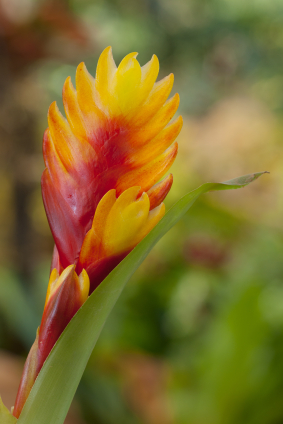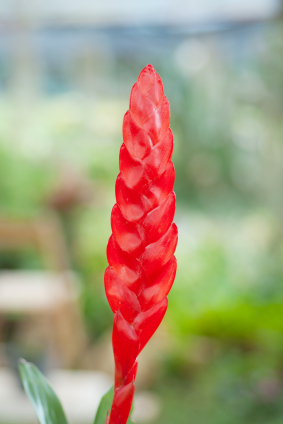Getting to Know Vriesea
Author: Melanie Dearringer10 Comments
Care and Culture, Classification

Vriesea is one of the forty genera of bromeliads. Within the Vriesea genus there are hundreds of different species and many more varieties and cultivars. Vrieseas are native to Central and South America, but are grown as indoor plants throughout the world. The Vriesea genus includes many small to medium varieties, but also incorporates some of the largest growing bromeliads. Vrieseas are very popular for their spectacular and long-lasting flower spikes. The Vrieseas that do not produce showy flower spikes usually have interesting foliage. It is rare that a Vriesea would have both unique foliage and a distinct flower spike.
Sunlight
Vrieseas are common indoor plants and many are easily found in garden centers. Vrieseas are very adaptable to a wide range of light. They will thrive in shaded areas as well as areas with bright indirect sunlight. Vrieseas are more tolerant of dense shade than other common bromeliads. The more sunlight a Vriesea receives, the more humidity it will need to avoid scorching the leaves. Vriesea foliage will also become more brilliant in color when exposed to more light. Moderate temperatures are preferred by Vrieseas, but they can withstand a range of low and high temperatures from just above freezing to 90F for a short period of time. They will not, however, survive a hard freeze. If you live in an area that is subject to freezing temperatures, do not plant your Vriesea outside. Consider using a container and moving it to a sheltered area once the weather becomes too harsh.
Form and Care

-A deep red and yellow Vriesea
Vrieseas typically have long, broad, flat leaves. They are smooth and do not feature any spikes or points. The foliage ranges in color from light green to purplish red. Many varieties have variegation or banding on the leaves. Most Vrieseas form a rosette with their leaves that create a central tank. Vriesea flower spikes are often tall, broad, and colored with shades of brilliant red, yellow, and orange. Like many bromeliads, Vrieseas are primarily epiphytic so they take in water and nutrients through the central tank. Their roots act merely as anchors to hold the plant in a potting medium or on a substrate such as a slab of wood. Vrieseas can be fertilized using a slightly acidic fertilizer diluted to a quarter of the recommended strength or less. During the growing season, April through October, thoroughly coat the all surfaces of the foliage with the diluted solution at least twice a month.
Water
Because of the epiphytic nature of the Vriesea, they are easily susceptible to crown rot. If the potting medium they are planted in remains soggy or moist, the roots will rot and ultimately destroy the plant. It is important to make sure the tank of the Vriesea remains wet, but not the potting medium. It is also necessary to flush the tank with fresh water weekly. This will prevent build up on the leaves and will also prevent insect development and stagnation. Using rainwater or distilled water to fill the tank will prevent a saline build up on the leaves. You can also provide humidity by misting the entire plant with a spray bottle.
Pups
Like other bromeliads, Vrieseas produce only one flower during its life cycle. Once the plant is finished flowering it will produce offspring called pups. These pups are exact replicas of the mother plant and can be removed and repotted once they reach half the size of the original plant. Because pups are usually top heavy it may be necessary to stake the plant until mature roots have formed to anchor the plant in the potting medium. For more information on pups, check out our free Beginner’s Guide to Bromeliad Pups.
Varieties
Vriesea splendens is a popular indoor plant often sold in garden stores and nurseries. It is native to Suriname, Venezuela and French Guyana. The plant has broad flat leaves that arc out from the middle with lengths from 8-24 inches. The foliage is green with brown, horizontal banding. The flower spike, which is also broad and flat, is bright red and reaches high above the foliage. There are several variations of Vriesea splendens that offer alternate shades of foliage and colors of flower spikes.
Vriesea ‘Fireworks’ is a cultivar that was produced from two other varieties of Vriesea: the ‘Velva Wurthmann’ and ‘Rosa Morena’. The result is a beautiful plant with glossy, bright green leaves. The flower spike is deep red rising from the center of the plant with several branching, narrow, flat offshoots.
In the Florida Council of Bromeliad Societies Photo Index of Bromeliads there are 198 species of Vrieseas listed and 713 cultivars. It is likely that any bromeliad enthusiast can find a unique plant that matches specific size requirements, need for light and color preferences both for foliage and flower spike. Be aware that many Vrieseas are larger in size than other bromeliads and the previous owner of the plant pups or a professional grower should be consulted regarding specifications for space requirements. Vrieseas also make impressive landscape plants if you live in a moderate climate. If your climate does not allow you to grow Vriesea outside, you must ensure you have space for them within your house, office, or greenhouse.

-This red Vriesea is very vibrant in color.
An article posted by the Australian Bromeliad Conference by Dr. Gilbert Samyn thoroughly discusses some of the history of Vrieseas cultivars. Dr. Samyn credits Belgian botanists and enthusiasts for being particularly successful in cultivating Vriesea hybrids. He sites the peak of enthusiasm for cultivating hybrids as being between 1879 and 1920. After that time, interest in unique plants decreased significantly. More people desired uniform, easy to care for varieties. Some of the hybrids have been lost since that time, other have been replicated in recent years and some have been consistently cultivated since the hybrids were first cultivated. Six cultivars that are still commonly used today are: V.’Mariae,’ V. ‘Wiotiana,’ V. ‘Cardinalis,’ V. ‘Intermedia,’ V. ‘Poelmanii’ and V. ‘Vigeri’. In more recent years interest in unique bromeliads has increased and the hybridization for Vrieseas is again more common.
One advantage for studying bromeliad hybridization is that certain species and cultivars can be found to promote specific desirable characteristics. One sought after characteristic in the bromeliad community is the plant’s resilience in cooler weather. A study showed that two Vriesea cultivars and two Vriesea species are more cold resistant than other Vriesea. V. ‘Marjan’, V. ‘Poelmanni’, V. hieroglyphica and V. zamorensis were discovered to be the top four Vrieseas for cold tolerance.
Diversity
Vrieseas are a truly diverse genera of bromeliad that includes popular and easy to find and care for plants particularly suited to the beginner bromeliad grower. Their high tolerance of various light levels make them an ideal indoor plant. Vrieseas also include unique and spectacular plants for the more advanced bromeliad enthusiast. Showy flower spikes and colorful, bowing foliage will earn the spotlight in any bromeliad collection. With the vast number of cultivars there is something for everyone within the Vriesea genera.
Sources
Florida Council of Bromeliad Societies Photo Index of Bromeliads. <http://fcbs.org/pictures/Vriesea.htm>
Samyn, Dr. Gilbert. “Vriesea Hybrids of Today and Yesteryear” <http://fcbs.org/articles/vriesea_hybrids.htm>
Stein, Geoff. “Introduction to Bromeliads” Dave’s Garden. <http://davesgarden.com/guides/articles/view/1648/#b>
VanZile, Jon. “Vriesea–How to Grow Vriesea Bromeliads” About.com Houseplants. <http://houseplants.about.com/od/bromeliad1/p/Vriesea.htm>
“Vriesea Splendens” Missouri Botanical Garden.
<http://www.missouribotanicalgarden.org/gardens-gardening/your-garden/plant-finder/plant-details/kc/b572/vriesea-splendens.aspx>
Photo credit: orange.tag.pixx via http://www.flickr.com/photos/orange_tag_pixx/3747280552/
10 Responses to “Getting to Know Vriesea”
Leave a Reply

Resource Download
Hechtia Care Cheat Sheet
Learn how to care for your Hechtia bromeliad with this quick and easy informational guide.
Learn More
Ask an Expert
Questions about bromeliads?
Our experts love a challenge!
Photo of the Week
Submit your photo to be featured on the blog!
More Photo of the Week Winners
Submit Photo








very informative
love your site. just starting out and will use it as my main source of info. t.x
I AM VERY NEW TO CARING FOR PLANTS. I AM UNFAMILIAR WITH THE WORD TANK? ?””It is also necessary to flush the tank with fresh water weekly.”
THANKS FOR YOUR HELP!
Check out our article titled “Bromeliad Basics: Watering” for more information and a photo of a bromeliad tank.
I think it means the place where the water collects.
I am currently growing lots of beaut vrieseas and won first prize in Mackay recently at plant show but having trouble with rot sometimes start at edge of leaves and then goes to crown. Can sometimes stop it by removing affected leaves.
thanks for advice really hepful
The flowers on my Vriesea (Vincent) are turning brown (I rescued him from the B&Q bargain bin a few weeks ago). He’s in an office with plenty of natural light but out of direct sun. I mist him every day and keep the tank watered but the soil dry, but the flowers still seem to be getting worse! Is this natural or is there something I can do? Might he need fertiliser? Re-potting?
Are the leaves looking ok? If it’s just the bloom, it’s possible it’s merely the end of it’s blooming cycle. It will not bloom again, but it should grow some pups (baby bromeliad plants) that you can later remove and have as new bromeliad plants.
I just purchased a small plant, I guess it is a pup. It is in a really little pot, and I am wondering when I should re-pot it into something a little bigger?